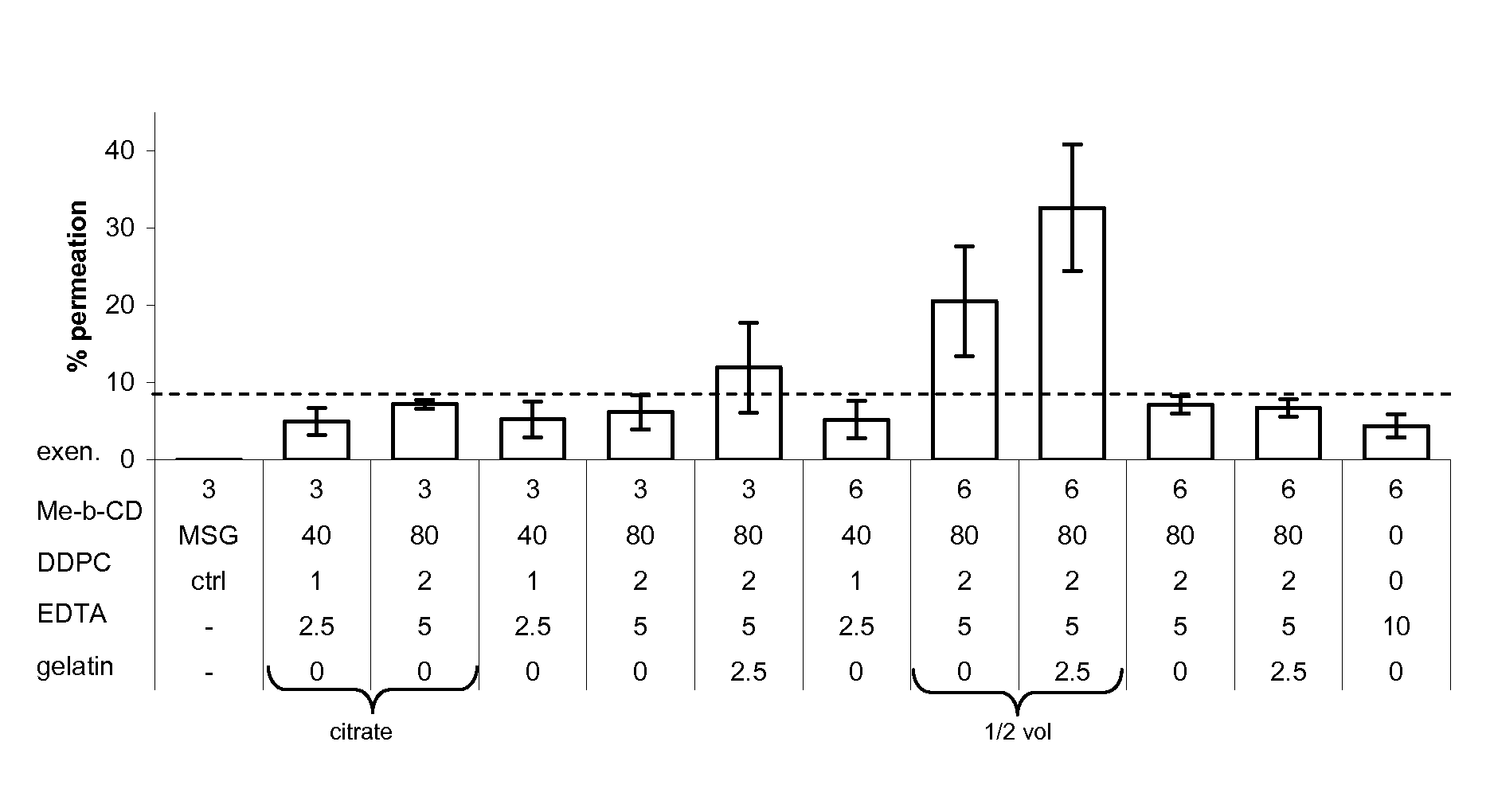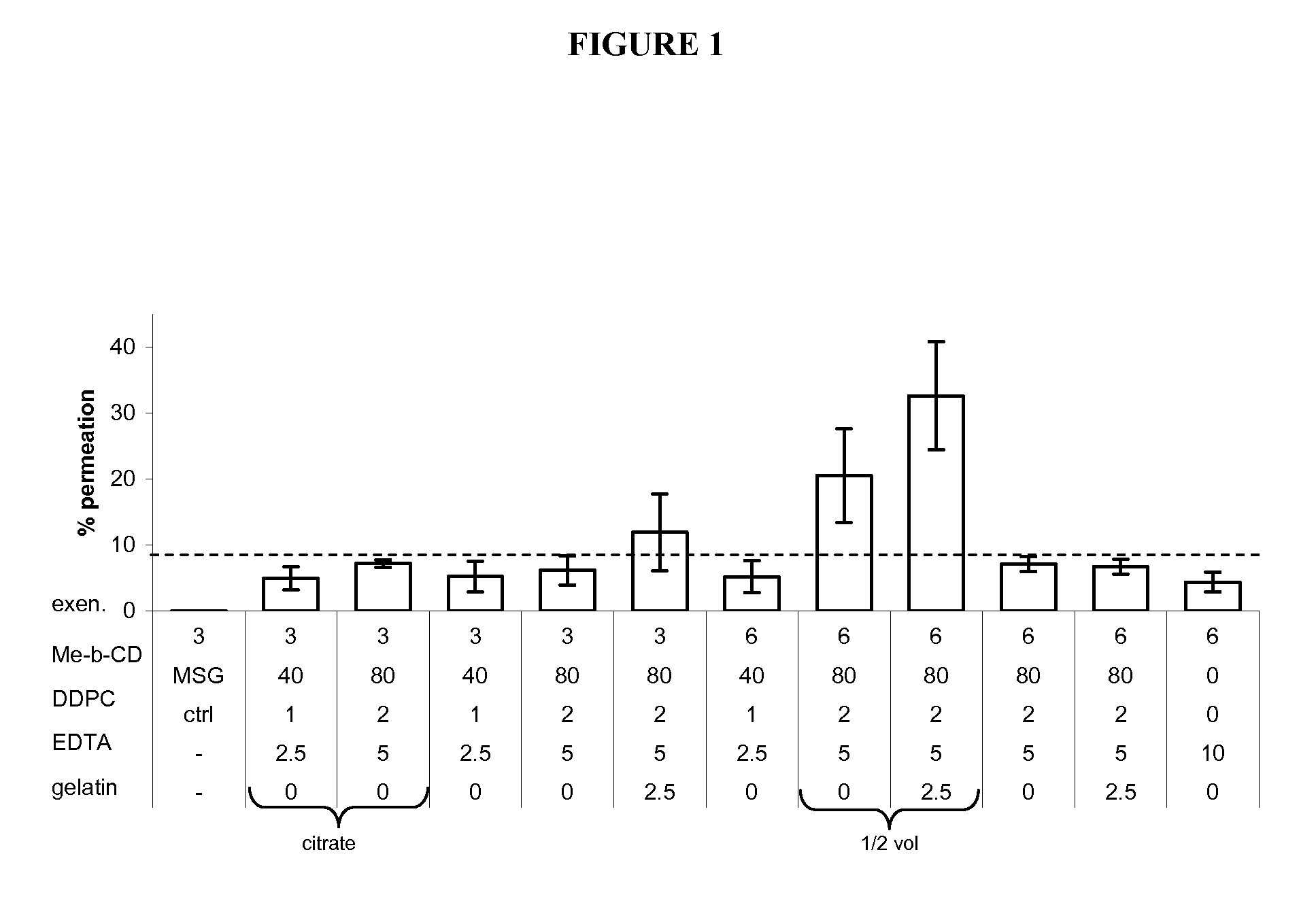Method of treatment of a metabolic disease using intranasal administration of exendin peptide
a metabolic disease and intranasal administration technology, applied in the direction of peptide/protein ingredients, spray delivery, metabolic disorders, etc., can solve the problems of patients developing needle phobia and the need for regular repeat injections
- Summary
- Abstract
- Description
- Claims
- Application Information
AI Technical Summary
Benefits of technology
Problems solved by technology
Method used
Image
Examples
example 1
[0215]Optimal transmucosal Glucose-Regulating Peptide (Exenatide) Formulations
[0216]In vitro optimization of transmucosal glucose-regulating peptide (exenatide) formulation
[0217]Transmucosal glucose-regulating peptide formulations were generated by combining glucose regulating peptide (exenatide) and excipients (including permeation enhancers, solubolizers, surface activants, chelators, stabilizers, buffers, tonicifiers, and preservatives).
[0218]Multiple rounds of formulation screening were performed and divided into two series, A and B. Series A focused on changing the excipient concentrations of solubolizers (Me-β-CD), surface activants (DDPC), chelators (EDTA), and stabilizers (gelatin). Buffers such as citrate buffer, tartrate buffer, and glutamate (MSG) were also tested. Series B screened alternative excipients for their potential to enhance exenatide permeation. Various concentrations of potential permiation enhancers including cyclodextrins, glycosides, fatty acids, phosphati...
example 2
Exenatide Formulations Induce Opening of Tight Junctions In Vitro
[0219]Transepithelial Electrical Resistance (TER) measurements using an in vitro nasal epithelial model
[0220]The cell line MatTek Corp. (Ashland, Mass.) was used as the source of normal, human-derived tracheal / bronchial epithelial cells (EpiAirway™ Tissue Model). The cells are highly differentiated and retain all the properties of respiratory epithelial tissue. The cells were provided as inserts grown to confluence on Millipore Milicell-CM filters comprised of transparent hydrophilic Teflon (PTFE). Upon receipt, the membranes were cultured in 1 mL basal media (phenol red-free and hydrocortisone-free Dulbecco's Modified Eagle's Medium (DMEM)) at 37° C. with 5% CO2 for 24-48 hours before use. TER measurements were accomplished using the Endohm-12 Tissue Resistance Measurement Chamber connected to the EVOM Epithelial Voltohmmeter (World Precision Instruments, Sarasota, Fla.) with the electrode leads. The electrodes and a ...
example 3
Exenatide Formulations Do Not Significantly Increase Cytotoxicity
[0223]Lactate Dehydrogenase (LDH) Assay
[0224]To verify that TER reduction by the exenatide formulations resulted from tight junction modulation by the permeation enhancers and not cell death, LDH and MTT assays were performed using the same cell line, MatTek Corp., as used in the TER assays. The amount of cell death was assayed by measuring the loss of lactate dehydrogenase (LDH) from the cells using a CytoTox 96 Cytoxicity Assay Kit (Promega Corp., Madison, Wis.). Fresh, cell-free culture medium was used as a blank. 50 μl harvested media (stored at 4° C.) was loaded in a 96-well plate. Substrate Solution (50 μl) was added to each well and the plates were incubated for thirty (30) minutes at ambient temperature in the dark. Following incubation, 50 μl of Stop Solution was added to each well and the reaction was monitored at A490 using an optical density plate reader. Media alone applied to the apical side served as a n...
PUM
| Property | Measurement | Unit |
|---|---|---|
| pH | aaaaa | aaaaa |
| pH | aaaaa | aaaaa |
| pH | aaaaa | aaaaa |
Abstract
Description
Claims
Application Information
 Login to View More
Login to View More - R&D
- Intellectual Property
- Life Sciences
- Materials
- Tech Scout
- Unparalleled Data Quality
- Higher Quality Content
- 60% Fewer Hallucinations
Browse by: Latest US Patents, China's latest patents, Technical Efficacy Thesaurus, Application Domain, Technology Topic, Popular Technical Reports.
© 2025 PatSnap. All rights reserved.Legal|Privacy policy|Modern Slavery Act Transparency Statement|Sitemap|About US| Contact US: help@patsnap.com



